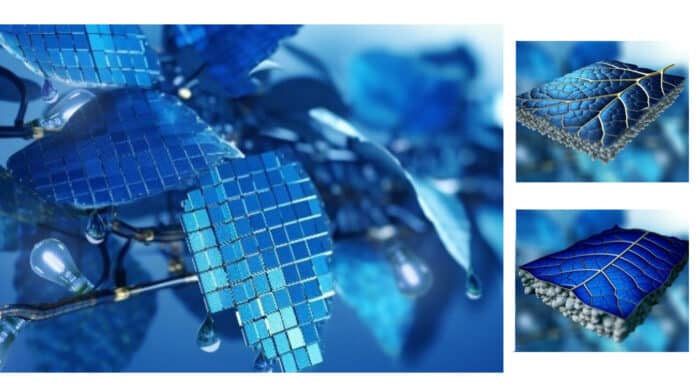Researchers from Imperial College London developed a novel solar energy design that resembled leaves and was inspired by nature. This design might significantly improve the efficiency of solar panels.
A normal plant leaf is made up of many structures that allow water to travel from the plant’s roots to its leaves via a process known as transpiration. It simulates the transpiration process by moving, distributing, and evaporating water. PV-leaf effectively and economically removes heat from solar PV cells by simulating leaf vein bundles with natural fibers and hydrogels.
Photovoltaic leaf (PV-leaf) technology, which converts sunlight into electricity, uses low-cost materials and has the potential to inspire the next generation of renewable energy technologies. The solar sector has seen the most development and new investment in renewable energy technology globally, especially photovoltaic (PV) systems, with an average annual growth rate of 24% over the last five years.
Active thermal management systems such as water or air fluxes and hydraulic structures are necessary to remove heat from PV panels. PV-based solar technologies still need more efficient thermal management solutions to achieve maximum solar efficiency.
The PV-leaf design eliminates the need for pumps, fans, control units, and costly porous materials while producing additional clean water and thermal energy and adapting to changes in ambient temperature and sunlight conditions. PV cells are sensitive to a section of the sun spectrum and lose energy as waste heat. High-efficiency and low-cost thermal management methods are essential for increasing the power generation of dozens of gigatonnes (GW) from present worldwide PV installations and mitigating the loss of hundreds of gigatonnes (GW) from future installations.
The PV-leaf design can generate almost 10% more electricity than conventional solar panels, which waste up to 70% of the incoming solar energy to the environment. If this novel PV-leaf design is utilized to reach the world’s 2050 solar panel targets, it may also produce more than 40 billion cubic meters of freshwater yearly.
Professor Christos Markides, Head of the Clean Energy Processes Laboratory and author of the study, said, “Implementing this innovative leaf-like design could help expedite the global energy transition while addressing two pressing global challenges: the need for increased energy and freshwater.”
Dr. Gan Huang, Honorary Research Fellow in the Department of Chemical Engineering and author of the study, said, “This innovative design holds tremendous potential for significantly enhancing the performance of solar panels while also ensuring cost-effectiveness and practicality.”
The UK Engineering and Physical Sciences Research Council and the Royal Society funded this research.
Journal Reference:
- Gan Huang, Jingyuan Xu. et al. High-efficiency bio-inspired hybrid multi-generation photovoltaic leaf. Nature Communications. DOI: 10.1038/s41467-023-38984-7
